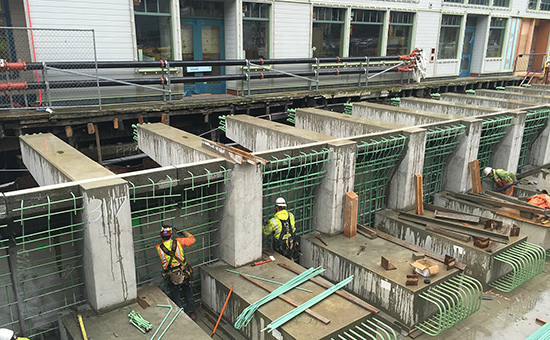|
Subscribe / Renew |
|
|
Contact Us |
|
| ► Subscribe to our Free Weekly Newsletter | |
| home | Welcome, sign in or click here to subscribe. | login |
Construction
| |
 |
January 22, 2018
National finalist: Gold award
Special Projects
Parsons

Project: Elliott Bay Seawall
Client: Seattle Department of Transportation
Parsons was the prime consultant on the Seattle Department of Transportation's Elliott Bay Seawall project. Its plan for replacing the existing 100-year-old downtown seawall included protections from wind-driven storm waves and erosion as well as support and protection of major utilities, state Route 99, the ferry terminal and nearby rail lines.
The project replaced three types of deteriorated seawall structures, ranging in width from approximately 15 to 60 feet. It also created a salmon migration corridor and near-shore habitat.
Consultants joining Parsons on the project included COWI and Exeltech. Mortenson/Manson was the joint-venture contractor.
Parsons' solution paired a soil-strengthening system with secondary structural elements that, together, provide the static and dynamic load-carrying capacity of the system. The improved soil mass, or ISM, approach involved a zone of secant jet-grouted, soil-cement columns in which soil is mixed with cement grout.
The use of jet grouting allowed for the construction of a large-diameter column from a small-diameter hole — necessary on a project that was hemmed in by existing timber piles left over from the original seawall's construction as well as existing utilities that had to remain in place during construction. The ISM was a key component of the lateral-force resisting system.
The system was coupled with more than 1,200 concrete precast elements to accelerate construction and reduce project cost. Many of these precast elements were designed to also improve fish habitat and increase overall ecosystem health.
An uninterrupted intertidal “migratory bench” runs the length of the seawall, providing improved bottom substrates that young fish are attracted to. Textured habitat shelves and panels along the face of the seawall promote marine growth.
And custom precast panels inset with glass provide an illuminated pathway underneath a 15-foot cantilevered sidewalk. This eliminates the shadows and canyons created by Seattle's urbanized shore that had drastically impacted the migration of native salmon.
The critical location of the ongoing project — abutting major tourist attractions such as the Seattle Great Wheel, Ivar’s Acres of Clams, Ye Olde Curiosity Shop and the Seattle Aquarium — meant that considerable planning was required to keep businesses open and the public safe.
Work zones along the seawall replacement were developed as discrete work areas with barriers and fencing, with gate staff to manage the construction traffic and pedestrian movements. Access to the pier businesses was maintained using temporary pedestrian bridges across the excavation, which had the additional benefit of allowing the public to see the construction of the new seawall in progress.
Far-reaching communication programs were put in place throughout the project, from design through construction. The public outreach team's social media efforts included a project Facebook page and Twitter account in addition to occasional blog posts by SDOT. Weekly project updates were sent out via email, and the outreach team staffed informational booths at several area fairs and festivals to keep the public informed.
The end result is a seawall that protects Seattle's waterfront as well as habitat below the water's surface.
Other Stories:
- National finalist: Platinum Award
Structural Systems
Magnusson Klemencic Associates - National finalist: Gold award
Structural Systems
COWI North America - National finalist: Gold award
Special Projects
Hart Crowser - Best in State: Gold Award
Successful Fulfillment of Client/Owner Needs
GeoEngineers - Best in State: Gold Award
Unique or Innovative Applications
Golder Associates - Best in State: Gold Award
Social, Economic and Sustainable Design
J-U-B Engineers - Best in State: Gold Award
Future Value to Engineering Profession
MIG/SvR - Best in State: Gold Award
Complexity
Stantec - Engineer of the Year


